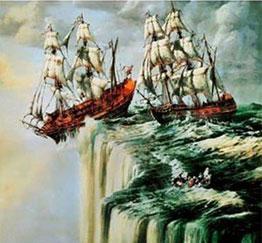COMMENT: Local schools still teach erroneous information about Columbus and 'flat earth'
It came to my attention last evening that the myth that Columbus was setting out to prove wrong the persistent belief of his time that the earth was flat is still being taught as history in our schools, even right here in Rossland, and I thought I’d shed some light on the situation. 20th century scholars have discredited the notion entirely, and traced the origin of the false story, known as the “Myth of the Flat Earth”.
This was largely a product of the nineteenth century, and part of the growing contention that religion was incompatible with science. By 1945, the false belief that medieval Christians believed in a flat earth was finally listed by the Historical Association of Britain as the second of 20 common errors in history.
While a number of civilizations in the ancient world believed in a flat Earth, the idea gradually came to be rejected by the Greeks. Around 330 BC, Aristotle provided observational evidence for a spherical Earth. Writing around 10 BC, the Greek geographer Strabo mentioned various phenomena suggesting that the Earth was round.
The first accurate calculation of the earth’s circumference was produced at Alexandria, around 240 BC by Eratosthenes, coming within a margin of between 2% and 20% of modern calculations. By the 1st century AD, Pliny the Elder could claim that everyone agreed the earth was round. And another Alexandrian astronomer, Ptolemy, whose writings remained the basis of European astronomy throughout the Middle Ages, advanced many arguments for the sphericity of the Earth.
In the late Roman period, well-known authors, like Macrobius, of the 4th century AD, and Martianus Capella , of the 5th, discussed the circumference of the Earth and its central position in the universe. In his commentary on Cicero’s ‘Dream of Scipio’, Macrobius described the Earth as a globe of insignificant size in comparison to the expanse of the universe.
While Europe languished in its own Dark Ages, science flourished in Muslim world, where Islamic astronomy inherited the idea of a spherical earth from the Greeks. In the 10th century, a Muslim scientist named Al Biruni solved a complex equation using trigonometry in order to accurately compute the Earth’s circumference, coming very close to modern values.
By the 11th century Europe inherited the advances of Islamic astronomy, and from the beginnings of Christian theology, knowledge that the Earth was round had become widespread.
Hermannus Contractus was among the first Christian scholars to estimate the circumference of Earth following Eratosthenes’ method. The leading universities of the time commonly advanced the idea that the Earth was a sphere, which was repeated by Thomas Aquinas, as well as in the most influential astronomy textbook of the 13th century, ‘On the Sphere of the World’. Dante’s ‘Divine Comedy’, written in the early 14th century, also portrayed the Earth as a sphere.
Jeffrey Burton Russell, Professor Emeritus of History at the University of California, says the flat earth mythology flourished most between 1870 and 1920, and had to do with the controversy created by the Theory of Evolution. The debate already had its origins in the Enlightenment of the eighteenth century, when French intellectual culture was focused on discrediting the Catholic Church, as part of its campaign to overthrow the aristocracy, arguing for the supremacy of “Reason”, or science, over revelation.
This perception of an antagonism between religion and science gained ground in the 19th century, when disputes surrounding Darwin’s theory contributed to the birth of the ‘conflict thesis’, a view of history according to which religion and science were seen as perpetually in conflict, with religion usually portrayed as opposed to the discoveries of science.
The myth entered popular culture with the publication of Washington Irving’s fantasy ‘The Life and Voyages of Christopher Columbus’, published in 1828, and mistaken by many as a scholarly work. In it, Irving wrote a fictional account of a commission established by the Spanish to examine Columbus’ proposals, featuring the fictional account that its bigoted members raised religiously-based objections to his contention that the Earth was round.
In reality, the issue in the 1490s was not whether or not the Earth was round, but rather its size, and therefore, the ability of European ships to sail that far across the ocean. In fact, Columbus’ small ships barely reached the Caribbean islands, when the crews became mutinous, but not because of some supposed fear of “sailing off the edge” of the Earth, but because they were running out of supplies.

























